Forsythia Jelly captures the wonderful flavor (and fragrance) of these early spring flowers, and you can enjoy their sunny flavor all year long.
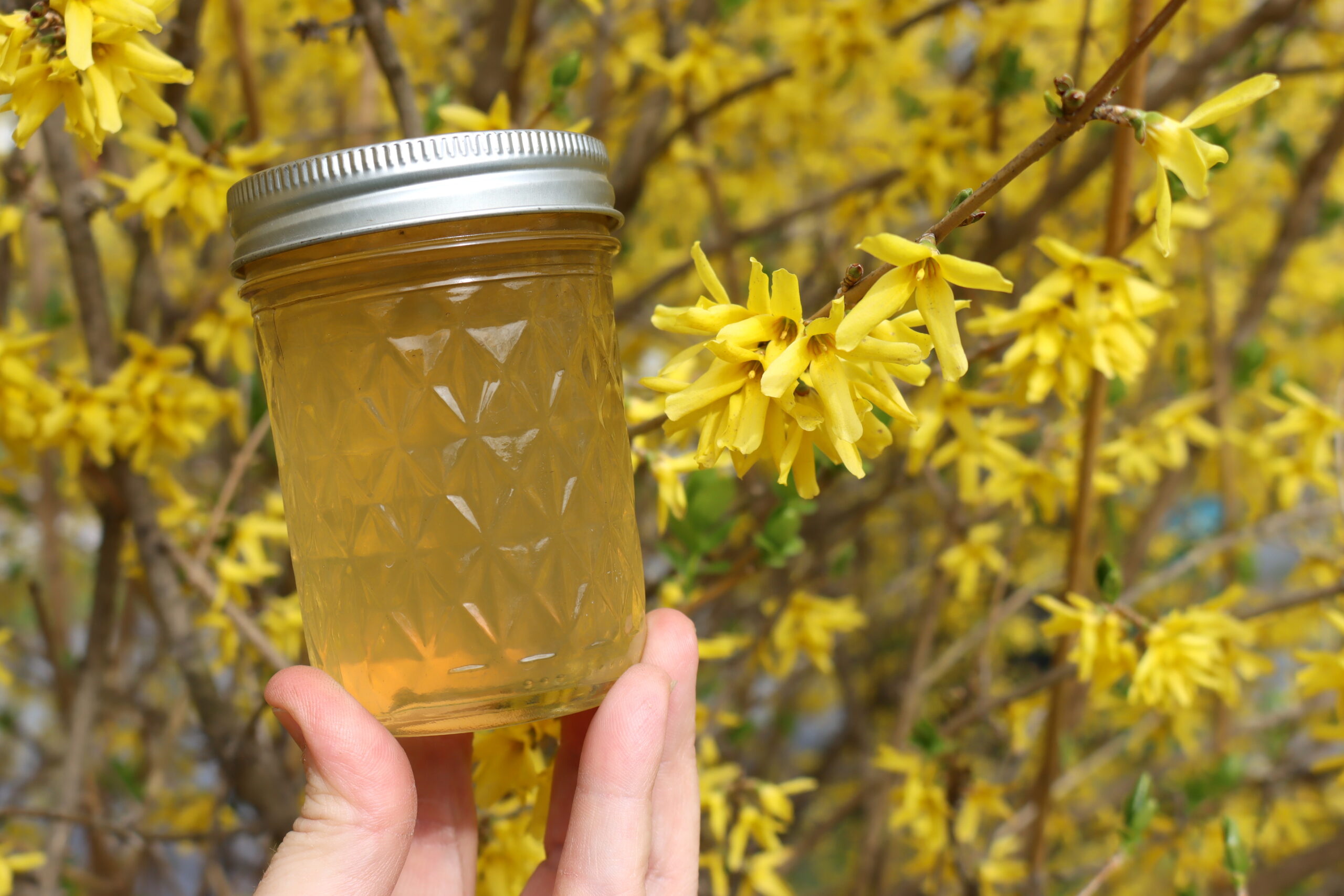
Forsythia is one of the first flowers of spring, blooming in a lush golden color as soon as the snow melts each year.
An otherwise unassuming bush bursts into color all at once, and it’s even more dramatic given that the leaves won’t come for another few weeks.
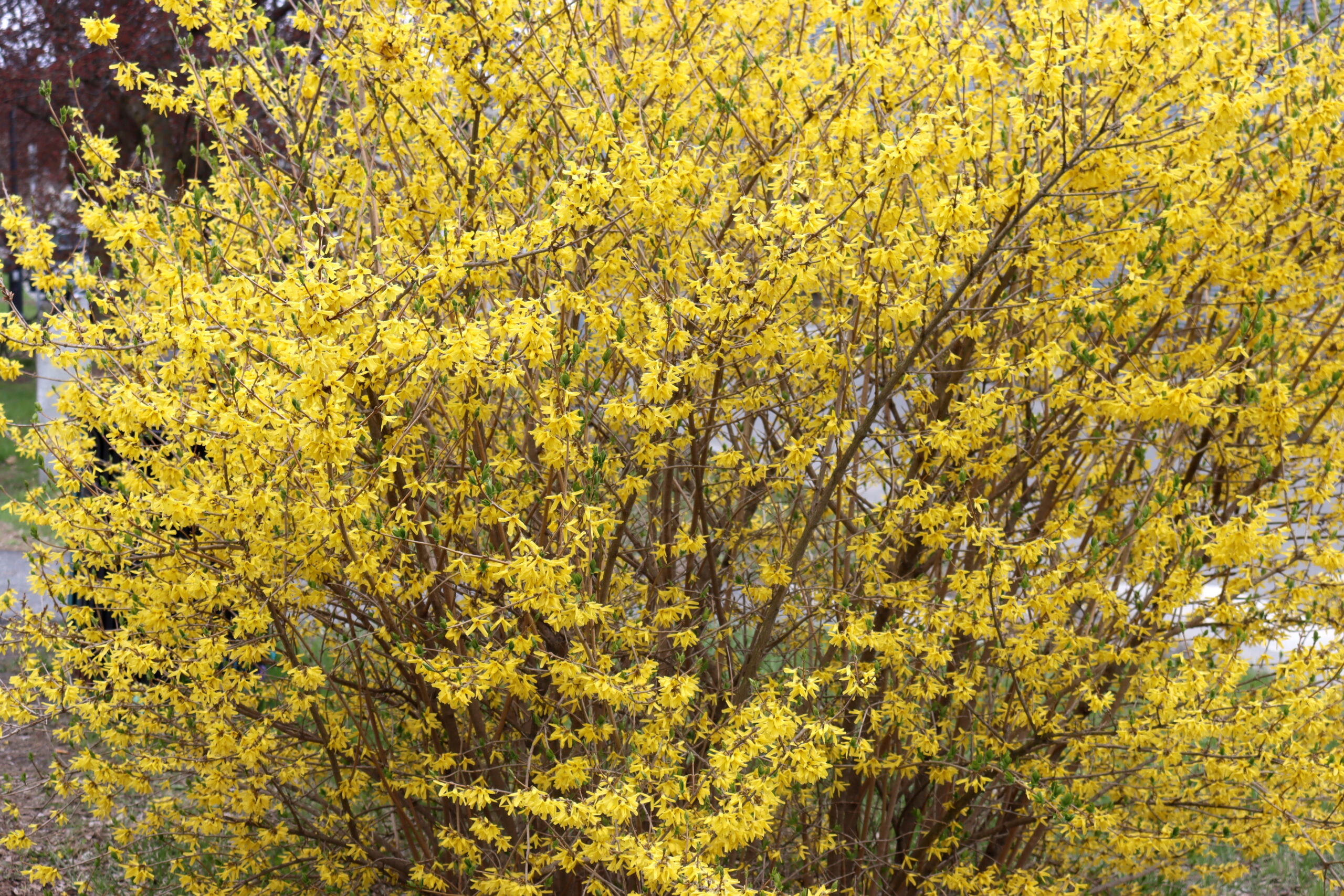
These unique bushes are incredibly popular, especially up here in the north country, where spring is a long time coming each year.
They’re lovely to look at, but I bet you didn’t know that forsythia flowers are edible! You can make them into all manner of tasty recipes, from cookies to tea, and even forsythia jelly!
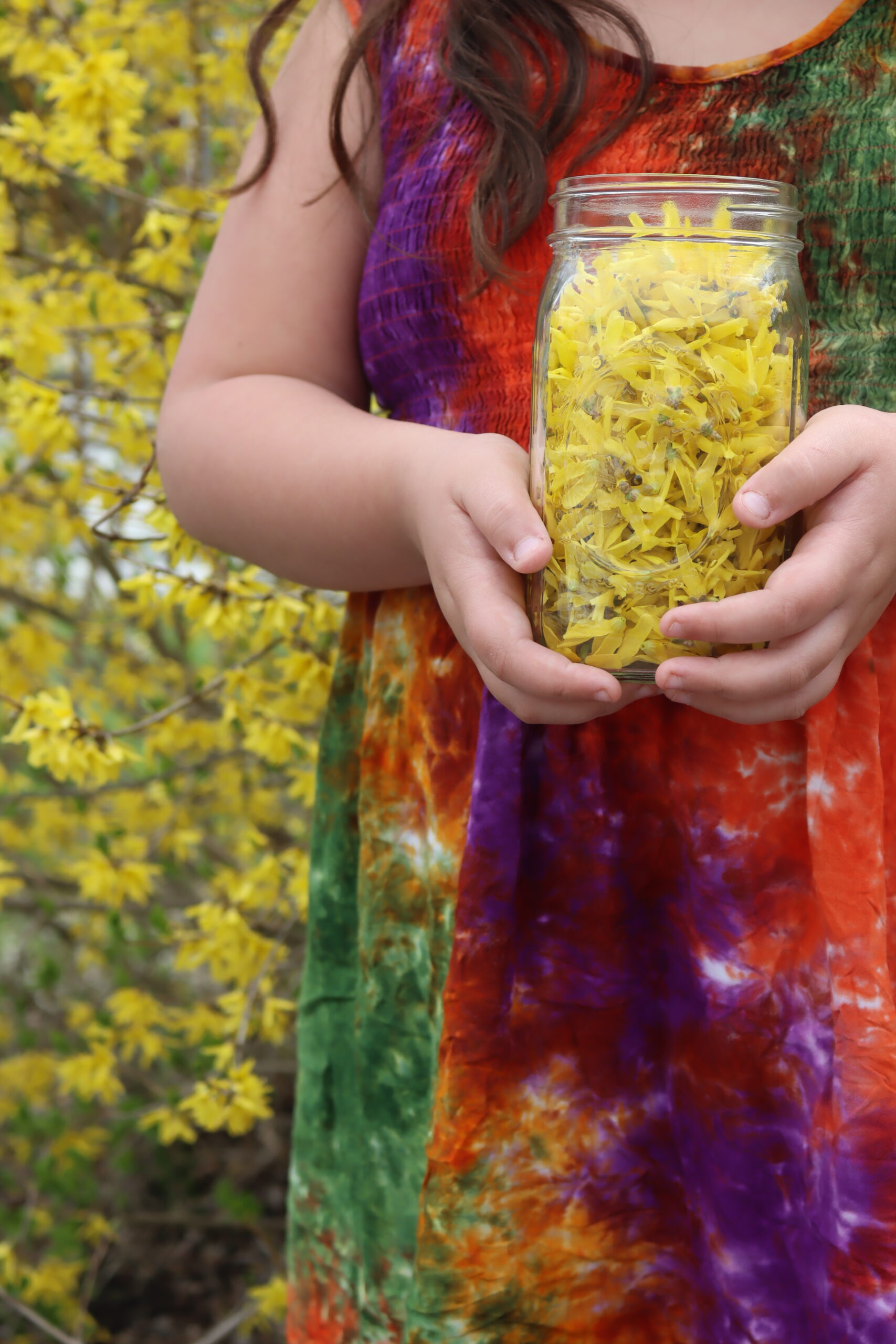
What does Forsythia Jelly Taste Like?
So that’s the million-dollar question. What on earth does forsythia jelly taste like?
Not surprisingly, it tastes floral and fragrant, like the flowers themselves…but it also tastes fruity, and if you close your eyes and sample a bit on a spoon, it actually tastes just a lot like peach jelly…but more complex and aromatic.
Up here in the north, peaches are a rare treat, and I’m especially fond of their juicy flavor in the early spring…so this forsythia jelly is extra special to us.
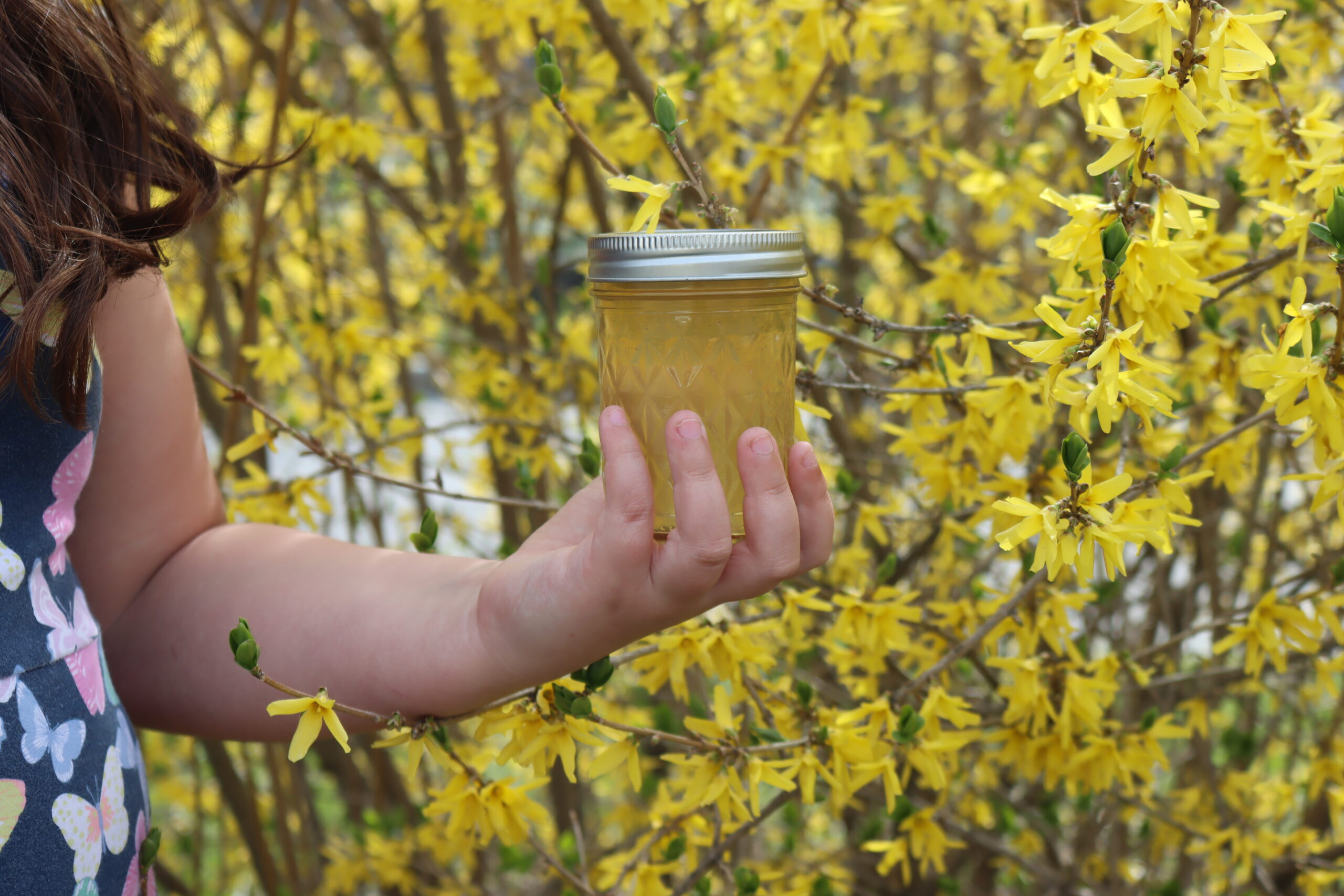
Harvesting Forsythia For Flower Jelly
The flowers themselves are easy to harvest, and they come off quickly into your hand.
A single bush produces gallons of blossoms each spring, so you’ll hardly notice the loss of a few cups of blossoms needed to make this forsythia jelly.
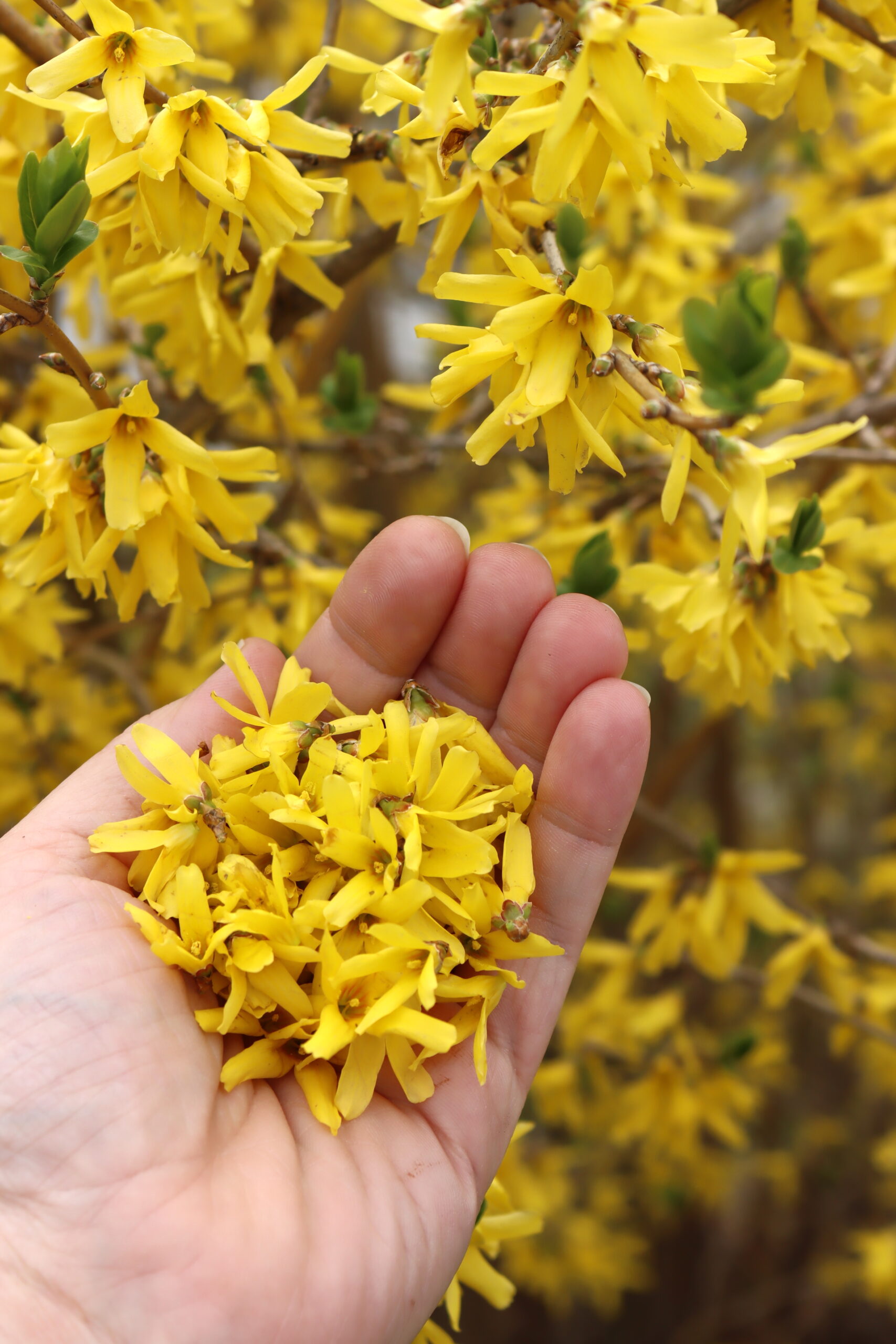
Ingredients for Forsythia Jelly
To make a flower jelly from Forsythia flowers, you’ll need freshly harvested blooms, plus water, sugar, pectin, and a bit of lemon juice.
For a 4 to 5 jar batch (8 oz each), you’ll need the following:
- 4 cups Forsythia flower petals (bases removed)
- 4 cups water
- 2 tbsp lemon juice (or ½ tsp citric acid)
- 1 to 4 cups sugar *see note
- 1 box (1.75 oz) pectin (Regular or Low Sugar)
The lemon juice helps balance the flavor of the sugar, adding a bit of tart contrast to bring out the flavor of the flowers. It also lowers the pH, which helps the pectin set, and also preserves the jelly and makes it safe for canning.
Even if you’re not canning the jelly, you do need lemon juice. If you want a more neutral flavor instead, you can use citric acid powder (dissolved in a bit of water).
Citric acid granules are much stronger than citrus juice, and they’re used at a rate of 1/4 teaspoon of citric acid in place of each Tablespoon of lemon juice (or lime juice) in a recipe.
This recipe has 2 Tablespoons of lemon juice, so you’d need 1/2 teaspoon of citric acid per batch.
For pectin, I generally use sure jell or sure jell low sugar pectin, as they’re really dependable and result in the best texture in my opinion. (I’ve tried just about every type of pectin on the market.)
For regular sure jell pectin, you’ll need to add a minimum of 4 cups of sugar because it’ll only jell with a 1:1 liquid to sugar ratio. Sure jell low sugar will gel with any amount of sugar, and you can use as little as 1/2 cup for a barely sweet jelly. I’d suggest using 1 to 2 cups for a lower-sugar recipe that’s still sweet enough.
(Sure jell low sugar can also be used with full sugar recipes, so that’s what I usually keep on my shelf because it works great regardless of the sugar you choose.)
If you have Ball Flex Batch Pectin, you’ll need 6 Tbsp. (which is equal to a 1.75 oz box of other types of pectin). That’s true for their regular and low-sugar canisters.
The recipe card below also has instructions for liquid pectin, which requires astronomical amounts of sugar (7 cups sugar to 4 cups liquid). I don’t use it, but some people prefer that type of pectin, so I’ve included it just in case.
How to Make Forsythia Jelly
Making jelly from Forsythia flowers isn’t all that different from making any type of floral jelly.
You’ll need about 4 cups of fresh blossoms.
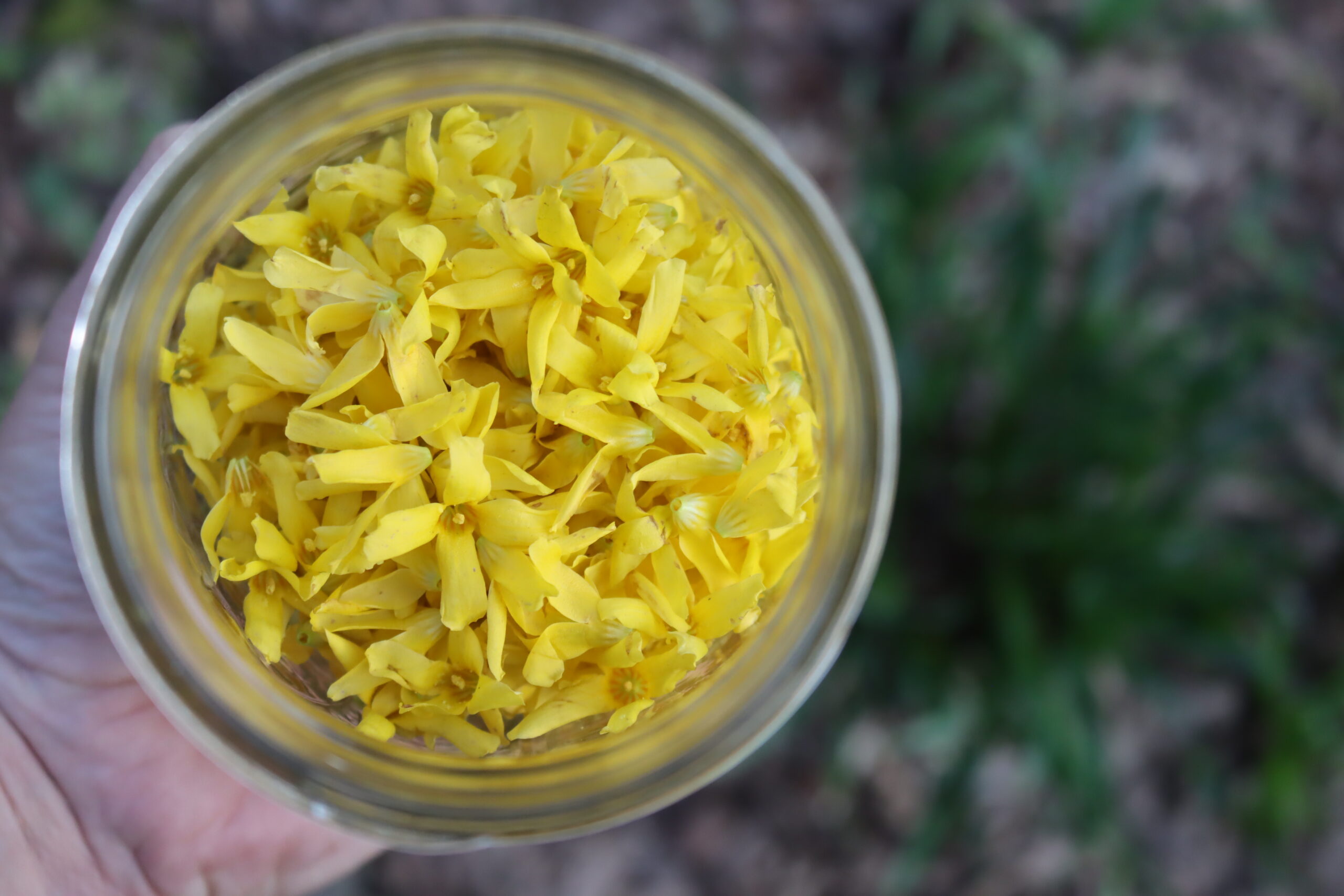
Cleaned Forsythia Flowers, green bases removed
In this particular case, you’ll need to remove the green base of each flower by hand, as it can make your jelly taste bitter.
The flowers themselves are sweet and fragrant, but that little green base doesn’t taste all that great. It is a finicky step, but it’s necessary. You have to do the same thing when you make lilac jelly.
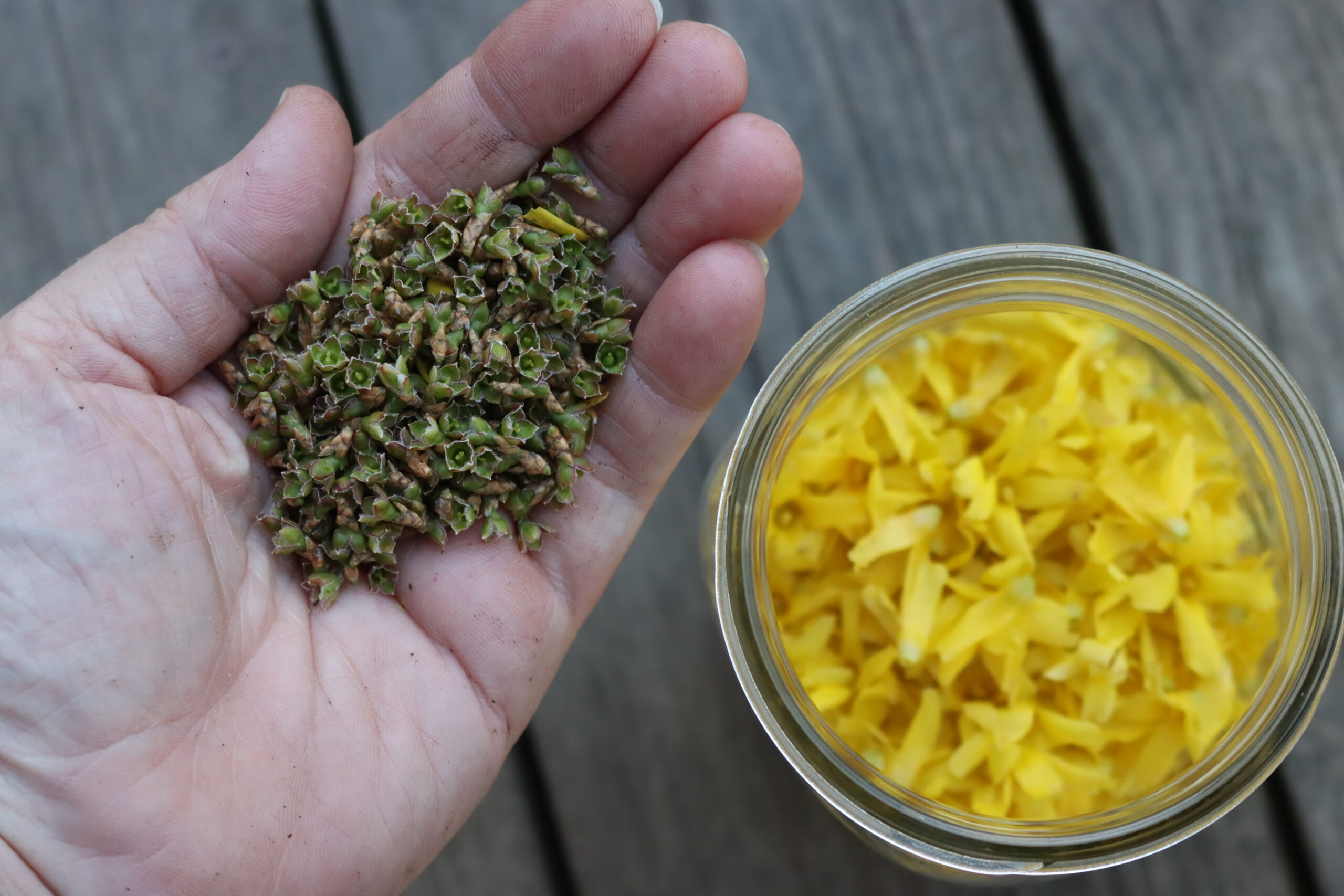
Put your cleaned forsythia flowers into a heat-proof container (like a mason jar). Now, we’re going to turn them into forsythia tea.
Pour 4 cups of boiling water over the petals.
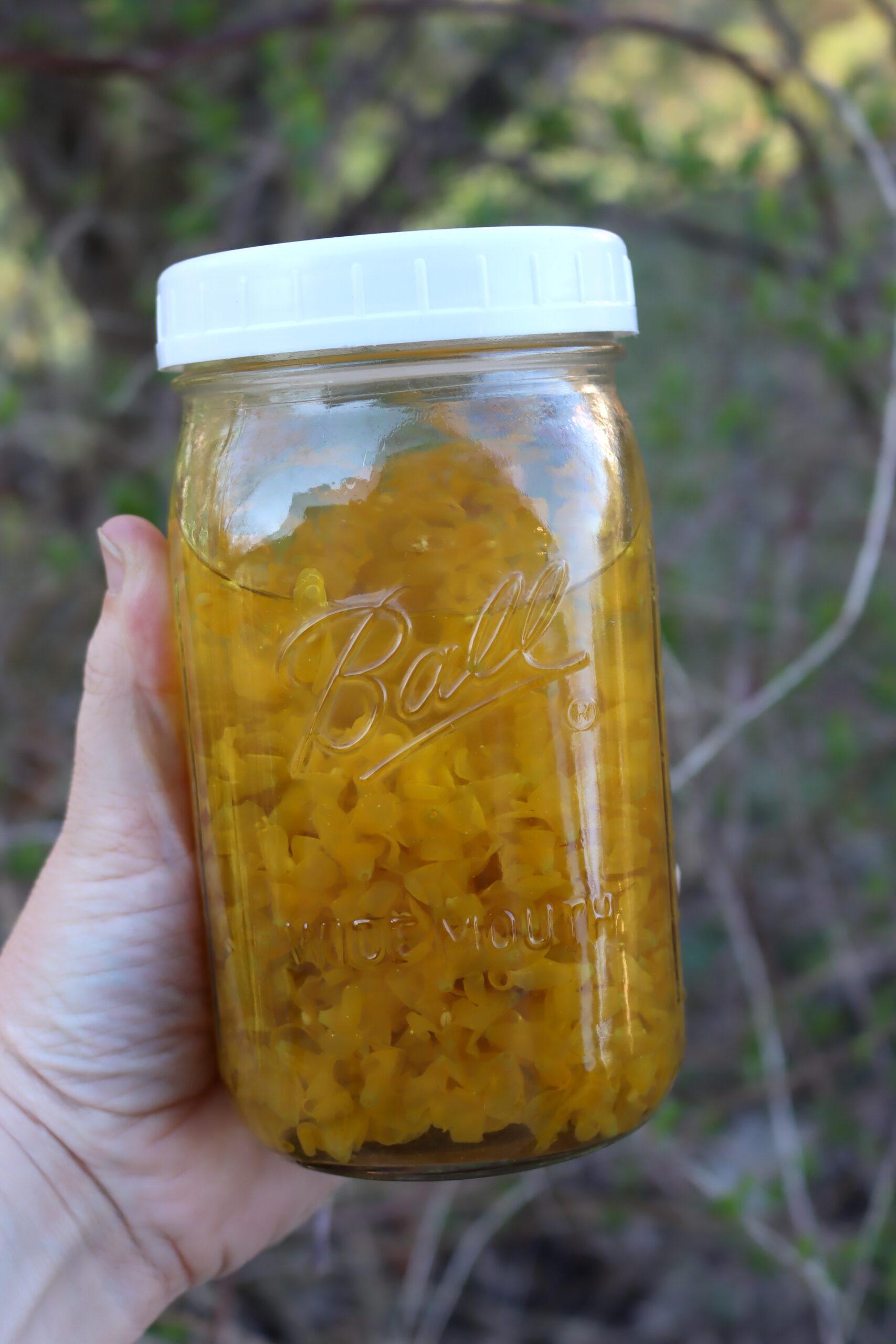
Steep the forsythia blossoms for about 15 to 20 minutes, and then strain.
At this point, you have forsythia tea, which is lovely in its own right. You can add a bit of sweetener (or not) and enjoy it as is, which will give you some idea of what your finished jelly will taste like.
Or, you can skip it, and just get on with making your jelly.
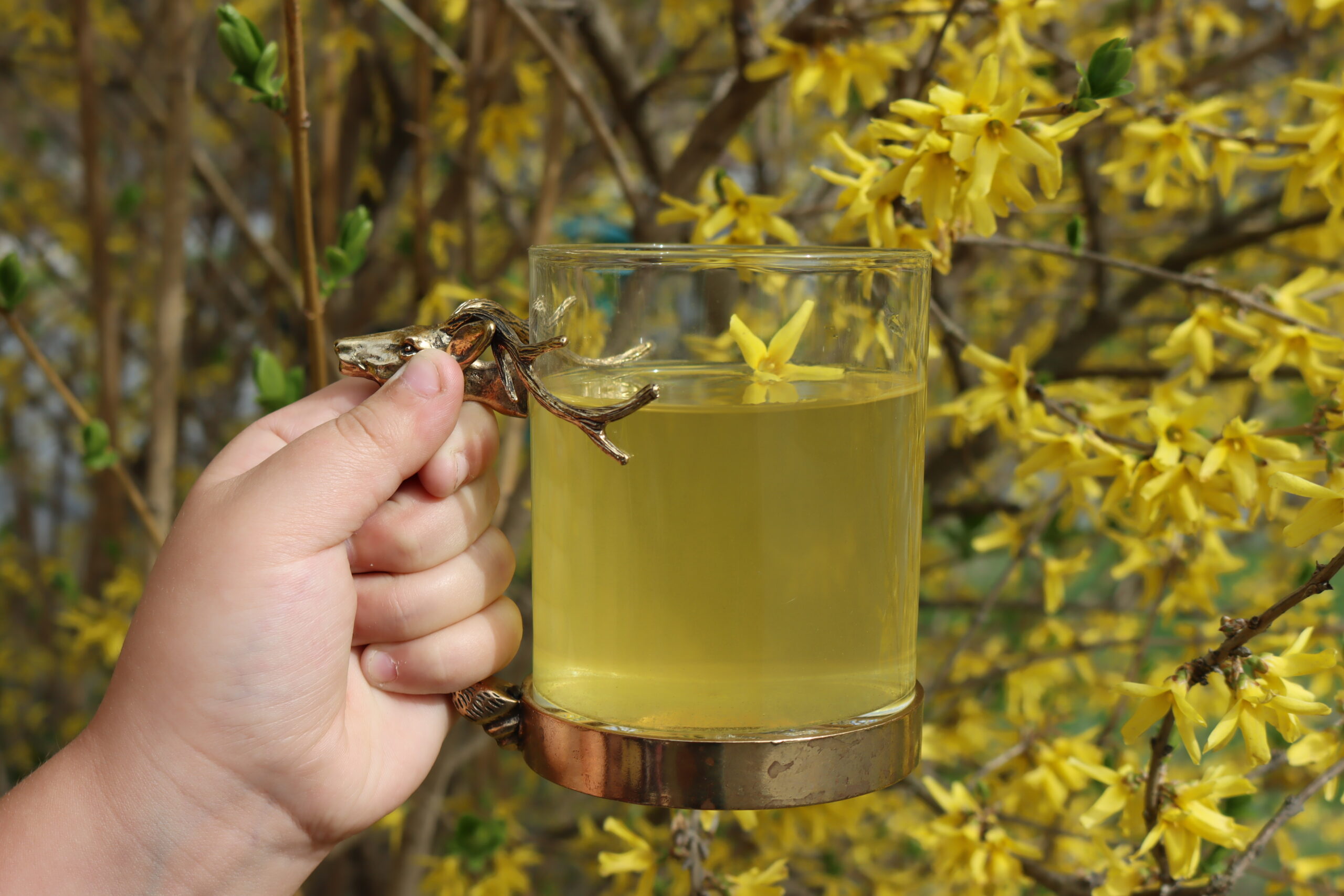
forsythia tea
Pour the Forsythia tea into a jelly pot and add 2 tablespoons of lemon juice. (The lemon juice balances the sweetness from the sugar, and also makes the jelly safe for canning. I’d recommend it even if you’re not canning your jelly.) Next, bring the tea to a boil.
Add in one box of powdered pectin. (I use sure jel brand usually, but any standard 1.75 oz box of pectin will work.)
Stir in the pectin until it’s completely dissolved, and boil for 1 full minute.
Next, add the sugar. Standard pectin requires a 1:1 ratio of sugar to liquid to gel. Since we’re working with 4 cups of forsythia tea, you’ll need 4 cups of sugar.
If you use a “low sugar” pectin, such as Sure Jel low sugar, then you can use as little sugar as you’d like. For a very low-sugar jelly, you can use as little as 1/2 to 1 cup of sugar to 4 cups of forsythia tea.
After you’ve added the sugar, stir to completely dissolve and return the mixture to a hard boil on the stove for 1 minute.
After 1 minute, remove the mixture from the heat and ladle it into prepared jars.

Canning Forsythia Jelly
Canning this floral jelly is optional, and you can simply store it in the refrigerator, where it’ll last several weeks. Freezing is also an option, provided you’re using freezer-safe jars.
Personally, I like the simplicity of processing the jars in a water bath canner because it allows me to store the jelly right on the pantry shelf year-round. I can have the sunny flavor of Forsythia jelly any time of year, and it’s not taking up refrigerator or freezer space in the meantime.
To can this jelly, be sure you’ve used lemon juice, which lowers the pH of the mixture enough for canning.
Prepare a water bath canner, canning jars, and lids before you start making the jelly. Make the jelly as otherwise, but then ladle into prepared canning jars leaving 1/4 inch headspace.
Seal the jars with 2 part canning lids and then process for 10 minutes in a water bath canner (15 minutes if above 6,000 feet in elevation).
Once the canning time is complete, remove the jars to cool on a towel on the counter. Properly canned and sealed jars will maintain quality on the pantry shelf for 12-18 months. Refrigerate after opening.
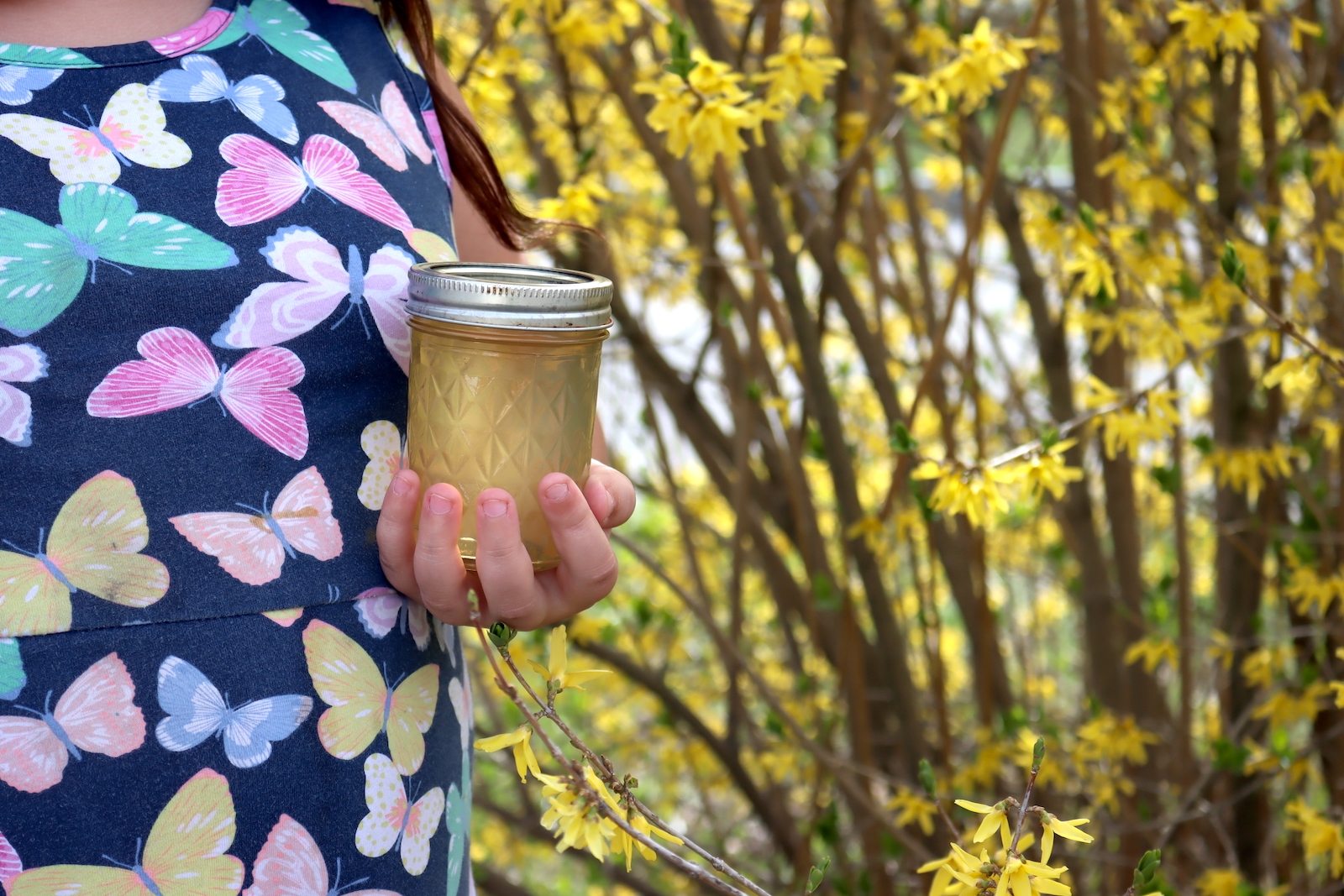
Forsythia Recipes
Looking for more ways to use forsythia flowers?
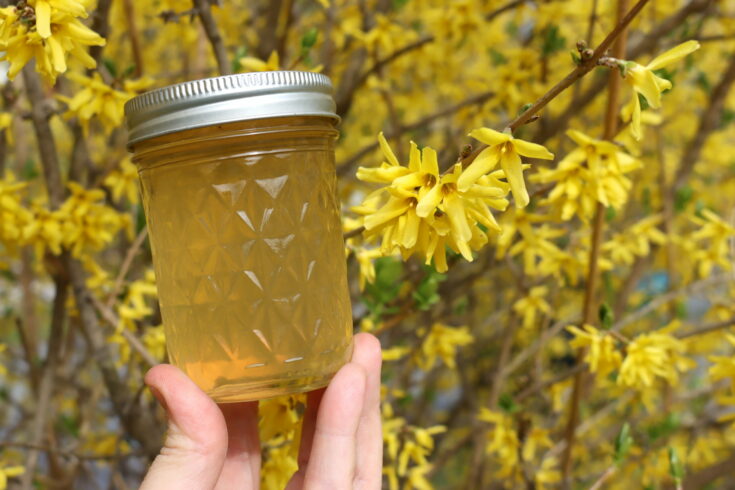
Forsythia Jelly
Forsythia jelly captures the flavor of fresh blossoms in a sweet floral jelly that tastes surprisingly like peaches!
Ingredients
- 4 cups forsythia blossoms, green bases removed
- 4 cups water
- 2 tbsp lemon juice
- 1 to 4 cups sugar *see note
- 1 box (1.75 oz) pectin (Regular or Low Sugar)
Instructions
- Separate 4 cups of forsythia flower blossoms from their stems, carefully removing any green parts. The green bases of each flower are bitter, so you really do need to remove them and use just the yellow petals. They slip off easily.
- Pour 4 cups boiling water over the top of the flower blossoms and allow the tea to infuse for about 10 to 15 minutes.
- Strain the floral tea into a saucepan or jam pot. Add the lemon juice, which will help bring out the best color in the jelly, but it's also required to balance the sugar in the recipe and help the pectin set. Beyond that, it adds acidity to help preserve the jelly, so don't skip the lemon!
- Bring the mixture to a boil and add the powdered pectin, stirring to dissolve. Allow the mixture to boil for 1 minute before adding sugar. (Note: Do not add the sugar at the same time as the pectin, or before the pectin, or the jell will not set.)
- Add the sugar, stirring to dissolve (See notes on quantity). Bring the mixture back to a full boil for 1 minute before ladling into jelly jars leaving 1/4 inch headspace.
- If canning, process in a water bath canner for 10 minutes. (or 15 minutes if above 6,000 feet in elevation.) Otherwise, allow the jars to cool completely on the counter before storing in the refrigerator (for up to a month) or the freezer for up to 6 months.
Notes
A note on sugar...
If using standard pectin, you must use a 1:1 ratio of liquid to sugar. That means for 4 cups flower blossom tea you'd need a minimum of 4 cups sugar to get the jelly to set. That results in a very sweet "old-fashioned" jelly. To reduce the sugar, simply use low-sugar pectin instead and then make the jelly as instructed but using less sugar. I suggest sure jel low sugar, which is very dependable.
Lowering sugar will also lower yield, and the yield of 5 half-pints is for a full sugar recipe.
If using Pomona's Universal Pectin, the instructions are different, as that is a 2-part low sugar pectin. Follow the instructions provided in the Pomona's box for mint jelly.
If using liquid pectin, the order of operations is different (pectin is added last, sugar first). Liquid pectin also requires a lot more sugar to set (7 cups sugar to 4 cups liquid). I don't recommend liquid pectin because of the high sugar levels required for set, but it will work if that's your preference.
If you have Ball Flex Batch Pectin, you’ll need 6 Tbsp. (which is equal to a 1.75 oz box of other types of pectin). That’s true for their regular and low-sugar canisters.
Flower Jelly Recipes
Stock your pantry with these tasty floral jellies!
Herbal Jellies
Flowers aren’t the only plants in the garden that make wonderful jellies!
- Savory Herbal Jelly
- Lemon Balm Jelly
- Calendula Jelly (Marigold Jelly)
- Mint Jelly (coming soon)
- Tulsi Jelly (coming soon)
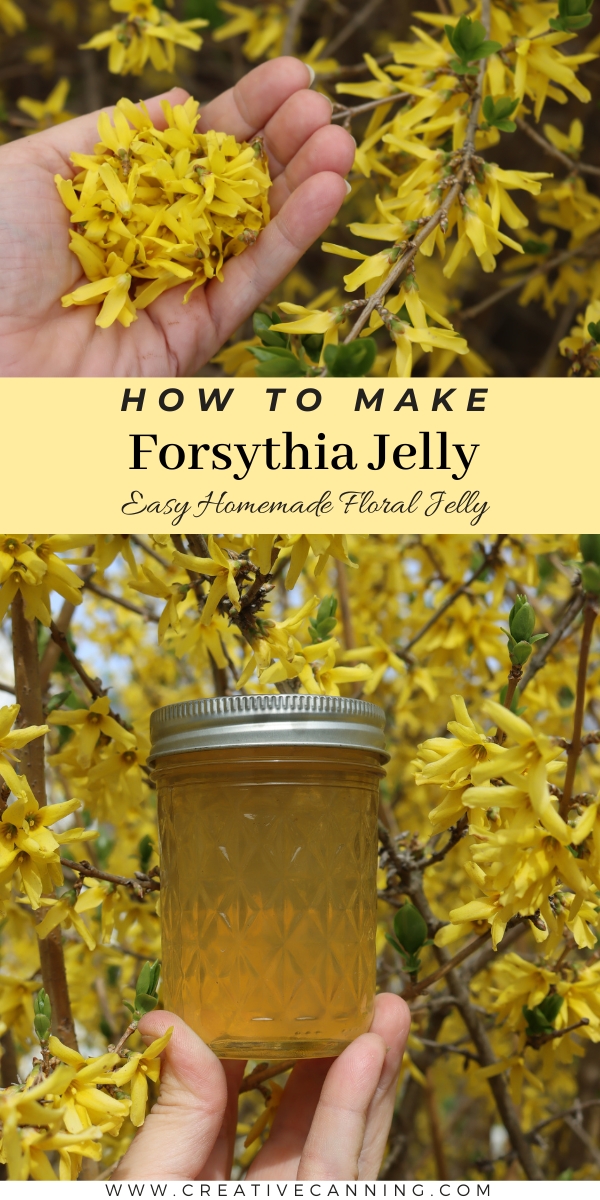
Vanessa
Love this idea! Could you share a few ways that you use it?
Ashley Adamant
Really any way that you’d use a jelly…on toast, in thumbprint cookies, and this one in particular makes a good glaze for pastries (in place of apricot jelly, that’s often used to glaze danish and such).